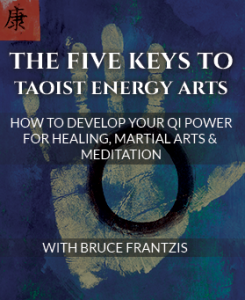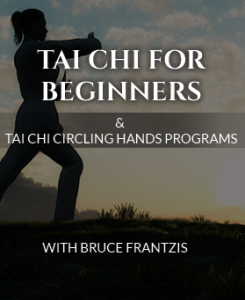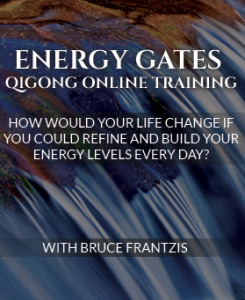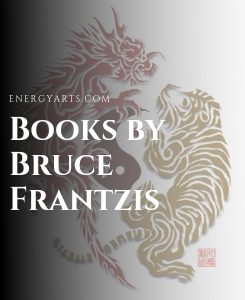I want to share with you some of my perspectives on using tai chi as a martial art. I know many of you mainly practice tai chi for health, but many others want to know how to use tai chi as an effective martial art and for self-defense.
I have seen a lot of comments about why we don’t see tai chi being used in MMA (mixed martial arts) and because it is not seen in that arena, it therefore must not be very effective. My own view is that tai chi can be as deadly as many other martial arts, in fact I would say it is better than most, but to be effective you have to go through the classical training progression, which few in the West undertake.
One could ask, “In the age of guns and mechanized weapons what is the usefulness of learning a martial art like tai chi?” I think it is important to recognize that the art of tai chi gives you the ability to be a master of different energies both in yourself and those around you. As you move toward mastery in tai chi you are at the same time moving toward mastering energy.
How many times have people tried to suck your energy dry? How many times in life has negative energy been directed at you either directly or indirectly? Were you conscious of this at the time and were you able able to make a choice about the best action or did you take a negative energy hit? Tai chi gives you practical methods to work with day-to-day situations learning to flow and move with energy so you can choose how to best use your energy. Few martial arts do this. Tai chi also works on the principles of water, that of flowing with the line of least resistance.
In my book, The Power of Internal Martial Arts and Chi: Combat Secrets of Tai Chi, Bagua and Hsing-i, I talk about four different stages of learning tai chi as a martial art. To go through all four stages requires ten to twenty years of learning and is only for the most dedicated (some would say extreme).
I studied full-time in Communist China in the Chinese language for eleven years (this was before I had a family). To put this in perspective, you can become a Western medical doctor in just over eight years. I say this to emphasize that traditionally, learning tai chi was taken as a full-time profession, not as a part-time hobby. Doing so enables a person to achieve extraordinary mastery of the tai chi form, energies of tai chi, and of course, superior fighting abilities.
Stage 1: Form Work (Long or Short Form)
This first stage can be broken into seven parts:
1) First you learn the moves separately.
2) Then you learn how all the moves flow together. You now learn to see and feel opponents attacking you from all different angles.
3) Next, you work with both speeding the form up and slowing the form down while staying connected.
4) Now you go back and learn in more detail all of the four energies that flow through each move. You start to do push hands here.
5) Next, you start to hardwire the 16 neigong internal components into your form. You separate and combine all of the internal components into your form.
6) Begin to hold specific tai chi postures for a specific duration. The neigong components are tested within each of the standing postures and usually progress with a learning sequence like this:
a) dissolving process, b) breathing, c) internal alignments, d) bending and stretching the soft tissues, e) unifying the body and its qi, f) the twisting of the soft tissue, g) opening and closings of cavities and joints, h) lower tantien work, i) spinal pumping, j) energy channel movements.
I don’t know of anyone in the West that teaches at this level of detail and precision.
7) The form takes on an evolutionary process determined by the individual. This involves working with specific neigong, repairing any short-comings and practicing to release the mind to stay completely in the present.
Much of the Energy Arts Tai Chi Mastery Program is about building a strong form. I wish I could say that it is common for teachers to help others build a really solid form including the internal energetics, but unfortunately I have not found this to be the case in the West.
To build a strong foundation you also need to know how each of the four primary energies within tai chi flows through the different moves. These are the four energies and brief martial applications:
1) Peng or Ward Off: Mastering this energy gives you an expansive internal power that is explosive.
2) Lu or Roll Back: Mastering this energy allows you to absorb your opponent’s energy. It is a yielding power that sucks in your opponent. The Tai Chi Classics say that your opponent ‘falls into emptiness’.
3) Ji or Press Forward: Mastering this energy gives you a straight ahead forward power. It is a focused power like a laser.
4) An or Push Downward: Mastering this energy allows you to root your opponent right into the ground and is a downward-moving power.
Stage 2: Tai Chi Push Hands or Tui Shou
Push hands is not fighting itself, but is a two-person exercise that develops most of the skills and types of power practitioners will need in combat, both open-handed and with weapons. Normally, you first learn empty-handed and then later practice with a variety of weapons.
There are four styles of push hands:
1) Single Push Hands: Partner’s hands continuously touch at the wrists and initially done while your feet are fixed.
2) Double Push Hands: There are three kinds of double-push hands: a) middle between single and double, b) large-circle push hands, and c) small-circle push hands. In all of the methods, your weight is constantly shifting between being forward-weighted and back-weighted.
3) Da Lu, or Four Corners, Push Hands: This style teaches how to move to diagonals, spin, turn around at 135-degree angles, and attack and defend from off-center and unusual angles.
4) Freestyle Moving Push Hands: This style allows you to freely combine at will the hand, waist and stepping techniques of double push hands and da lu, in freestyle movements.
If you love tai chi and have not yet discovered push hands, you are in for a treat as it is a special practice that is both fun and what many call addictive.
Stage 3: Transition Methods Between Push Hands and Sparring
Push hands is not fighting or even sparring. So, you have to make the jump. There are three methods that get you from push hands to sparring:
1) Practicing single fighting applications with a partner: This method is not much different from sparring in karate or tae kwon do. Initially in tai chi, you begin with fixed feet. Only after your hand techniques, kicks, throws, and joint locks are up to standard, do you move your feet in accordance with the principles of push hands.
2) Circling Hands: This practice is similar to bagua’s Rou Shou. Each partner attempts to create an opening through which the other can be hit with a tai chi hand technique.
3) Two-Person Sets: In these sets, two people attack and defend themselves over and over again in a long, prearranged sequence. Initially the forms are done slowly and then gradually the speed is increased.
In all three of these transition methods, the focus is on gaining the skill to recognize which energies inherently defeat what other energies.
Stage 4: Sparring and Actual Fighting
Sparring has a hundred times more variables to be handled than push hands. Yang Lu Chuan is said to have spent six years learning only the fighting and sparring strategies of tai chi. Free-style sparring is quite different from actual life-and-death combat. People respond very differently when they feel their survival is at stake, as opposed to when only winning and losing is at risk.
From the traditional tai chi perspective, fighting called lan tsai hua is push hands with the following added:
- Distance appreciation
- Ability to flow between close, middle and long fighting distances
- Fighting angles
- Hitting, kicking, throwing, joint-locking, and the ability to absorb blows
- The ability to touch, disengage and tough again, fluidly and without discontinuity
- The ability to stay centered and calm regardless of danger, attempting to transcend the instinctual animal fight-or-flight reaction
- Training aimed at being able to defend against high and low attacks from multiple opponents advancing at multiple angles
- Bare hands versus weapons training
The classical fighting training exists on two levels. The lower level is concerned pragmatically with how to hurt or kill your opponent. The highest level, achieved by the famous Yang Lu Chuan who was called “The Invisible,” is where, instead of hurting your opponents, you are able to throw them some distance through the air without hurting them at all, using nonviolent fa jin. An opponent who is not physically harmed is often relieved of an inner need to seek revenge.
The internal martial arts are very powerful, but their effectiveness requires full commitment, time and dedication. Whatever your interest level, whether 20 minutes several times a week, or as something you do as a profession, I believe that tai chi gives you back more than you put in. I think knowing these four stages can help you if you are just starting off, or even if you are a teacher of the art, and especially if you are interested in tai chi as a martial art.






0 Comments